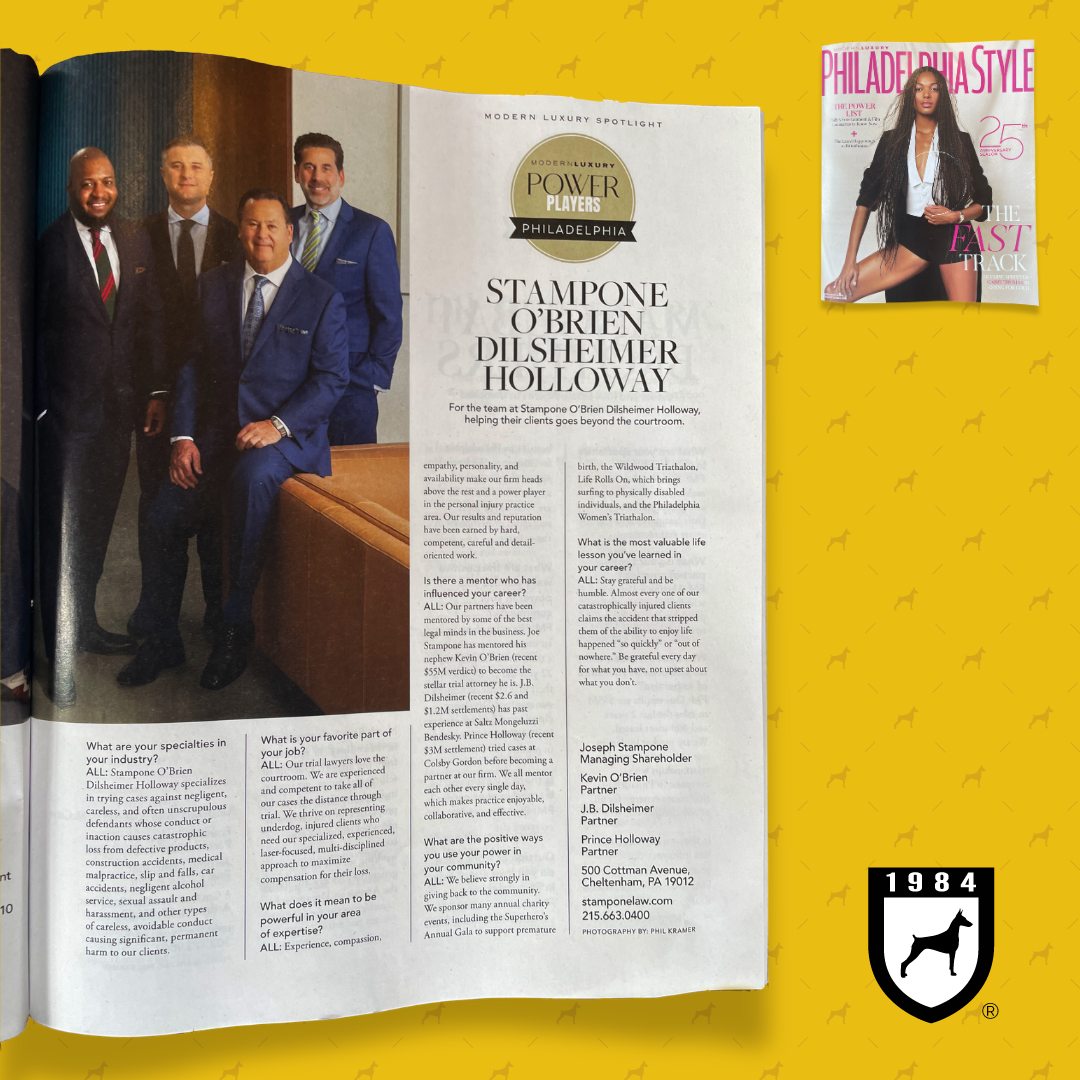#WeTriCases
#WeTriCases
Stampone O’Brien Dilsheimer Holloway is a proud partner of DelMo Sports and the title sponsor of the Stampone O’Brien Dilsheimer Holloway Women’s Philly Tri and Tri the Wildwoods Triathlons.
As a leading personal injury law firm in the Mid-Atlantic region and members of the Philadelphia and Wildwood communities, we are honored to support our friends, families, and neighbors in their competitive pursuits, just as they have always supported our firm.
5 Gifts for the Triathlete
Unsure what to get the Triathlete in your life this holiday season? Here are our top 5 picks for safe swimming, running, biking, and post-race recovery.
1) A Gift For The Swimmer: Open Water Buoy
Many triathletes, including our friends at the Wild Harbor Tri Club, train in open water. While a pull buoy helps to balance your lower body within the water and build strength in your torso and arms, we recommend them for safety above all else. A bright yellow or orange buoy will increase your visibility to other swimmers and watercraft, and also provides a safe place to float and rest. Most buoys, including the Swim Buddy and the New Wave, can be found online for less than $50.
2) A Gift For The Runner: Compression Sleeves
For many people, the impact of running, particularly after a grueling swim, can be tough on their muscles. Wearing compression sleeves on your arms and legs helps to increase blood flow to the muscles and accelerate oxygen and nutrient return to ease muscle fatigue and reduce swelling/inflammation. In turn, this reduces the odds of cramping and subsequent injury. Compressport and 2XU sleeves can be found online from $30-$60.
3) A Gift For The Biker: Helmet
Perhaps the most important piece of safety equipment for a triathlete, many of the injuries we see in our law firm’s handling of bike accident claims could have been mitigated or avoided entirely if the rider was wearing their helmet and wearing it properly. When choosing a helmet for the triathlete in your life, you should focus on safety, performance, and airflow. We like the Louis Garneau P-09, the Giro Aerohead MIPS, as well as the stylish POC Helmet, which cost between $200 and $250.
4) A Gift For Post-Race Recovery: Percussive Therapy Devices
When it comes to health and safety, what you do to recover after a race can be just as important as what you do to prepare beforehand. Various percussive therapy devices, including the Theragun, vibrating foam rollers, and smart muscle stimulators can be used at both times making them a great gift for any triathlete. Not only do they help with recovery after an intense workout and relieve common day-to-day soreness, but they have also been proven to reduce stress and improve sleep. Although there are many options out there, we like the products from Therabody, including the Theragun Mini.
5) An “All-Purpose” Gift For The Triathlete: Heart Rate Monitor
Staying within your physical limitations during strenuous exercise is one of the hardest aspects of training for any triathlete. Fortunately, there are affordable heart rate monitors that not only help to improve performance and maximize the benefits of training, but also serve as a safety parameter. Heart rate monitors indicate stress-related heart rhythm disturbances and serve as a good reminder to slow down, rest, and live to compete another day. We recommend a waterproof monitor, like the Garmin HRM-Tri, which can be used during all three phases of the race.
4 Tips for Nighttime Running and Jogging
Daylight savings happened just a few weeks ago and as much as we all enjoyed the extra hour of sleep, those of us who run and jog after work are left to contend with a slew of new safety concerns that come with decreased visibility.
In honor of November being National Running Safety Month, we recommend all nighttime runners and joggers follow these 4 safety tips before leaving home:
Take your cell phone.
While running and jogging appear to offer the perfect opportunity to unplug and escape the endless phone calls, emails, tweets, and texts that keep us glued to our screens, it’s not worth the risk of getting caught upstream without a paddle. Whether you’ve been injured, lost your way on a long/exploratory jog, or just need the extra lighting, the safety utility your cell phone provides in an instant is unmatched. Turn it off if you must, but don’t leave it at home.
Tell someone where you’re going.
Whether it’s a text message, a yellow stickie note, or simply shouting to a loved one, you should always tell someone where you are going and how long you expect to be gone before embarking on a run/jog. If an emergency arises, this vital information will give rescuers an idea of where to look for you and how far you could have gone.
Make yourself visible (“See and be seen”).
After all, how can someone avoid you if they can’t see you? Flashlights, bright clothing, and reflectors are all ways to increase your visibility but should not be relied on this time of year. The best way to stay safe this November is to run/jog on well-lit roads and paths where you can see and be seen.
Know your route:
This doesn’t mean run the same exact path every time you exercise, but rather to familiarize yourself with your surroundings before venturing into the night on your own. By identifying blind spots, potholes, unusual traffic patterns, and other obstructions in advance, you can spend more time focusing on your workout and less time worrying about dangerous conditions.
4 Tips to Beat the Summer Heat
There is no better time to train than summer. The sun is shining, the flowers have blossomed, and there are lots of DelMo Sports events to look forward to. However, due to the potential of heat-related injury and sun damage, precautions must be taken. Here are four tips to help avoid injury this summer:
Get acclimated to the temperature
The most effective way to prepare for a triathlon is to train in the same conditions in which you will be racing. For those ready for to hit the DelMo Sports circuit of races, this means training in hot temperatures to avoid heatstroke and other injury. Try moving your morning workout routine to the early afternoon. If you work a day job, you can replicate high temperatures by wearing extra layers of clothing or turning your air conditioning off for indoor training.
Listen to your body
Maintaining perspective on yourself, especially during strenuous physical exercise, is one of the hardest aspects of training for any athlete. We engage in strenuous activity and push ourselves to the point of exhaustion often with no regard for our own well-being. This is a reminder to you listen to your body as you train, especially in the hot and humid summer months. Be aware of the signs of heat stroke and dehydration in yourself and your training partners. Common symptoms include lightheadedness, dizziness, profuse sweating, and nausea.
Stay hydrated
Seems obvious, right? Not always, as our bodies have a counterintuitive reaction to heat-preparedness. As you train and your body gets used to the heat, it will begin to regulate its temperature sooner by increasing your sweat rate. While this is just your body’s way of cooling down, it leads to quicker dehydration. So even if you have been training for months, be sure to drink plenty of fluids long before and after your exercise.
Wear quality eyewear
To triathletes at all levels, choosing the right sunglasses is vital to protecting one of the most important safety features during a race and training, your vision. While a decent pair of sunglasses will help divert winds, dust, debris, and other elements on the bike and run legs of a triathlon, on a hot and sunny day they will also enhance your visibility, reduce glare, and keep sunscreen out of your eyes. This decreases the eye’s tension and stress allowing for peak performance and increased safety.
6 Tips for Novice Triathletes
Be organized
Between clothing, equipment, and additional items like fitness trackers or sunscreen, it’s easy to overlook details on race-day. We recommend creating a checklist and organizing your gear the night before to avoid a hectic morning.
Arrive early
Be sure to arrive with enough time to address crowded parking lots, equipment-related problems, check-in lines, transition setup, and your own personal race prep. The last thing you want is to be breathing heavy before the opening gun.
Stay calm, even when the sea isn’t
For most triathletes the swim is the toughest leg of the race, both physically and mentally. While we are unable to control the sea’s current or temperature, we do have control over our reaction to these elements. Don’t make the swim harder or longer than it must be – stay calm and stay straight.
Practice transitions
Valuable time can be lost changing from your wetsuit to your cycling gear and from your cycling gear to your running gear. Practice these transitions at home before race-day to cut vital seconds/minutes off your final time.
Check your bike (and don’t lose it)
Make sure your bicycle and helmet are together and in proper working condition before beginning the race. With hundreds, if not thousands, of similar styled and colored bikes piled together in a carousel, its easy to get lost, especially in the heat of competition. If you are one of the first to set your bike down, we recommend going back once the area has filled to refamiliarize yourself with your bike’s location.
Have fun
You won’t find a more supportive, fun-loving group than triathletes. So, whether you are there to compete, get yourself in shape, or support a friend, family member, or charity, please remember to have fun! Embrace the fact you are trying something completely new, in what is sure to be an incredible location.
3 Springtime Training Tips for Triathletes
After a winter of semi-hibernation, it’s time for triathletes to make the switch to spring/summer training. Before ripping off those leg warmers and hitting your local trail, read our three tips for springtime training:
Patience, runners, it’s a long season
Many triathletes take the winter season as a time to regroup and recover. If it’s been a few months, or even a few weeks since your last run, be careful risking an early-season injury by overexerting yourself. It is recommended runners do not increase their training by more than 10-15% in terms of mileage or time while returning to pre-winter status. In other words, patience is the key to avoiding injury.
April showers bring wet, slippery trails
We are all for enjoying nature and embracing the rain, but the dangers of running or biking on a wet, muddy trail can’t be overlooked. Aside from the obvious slip and fall hazard, hidden defects disguised by rain puddles can cause significant injury to the unsuspecting runner or biker. But don’t let a little rain stop you; find your nearest paved trail, track, or secure street to complete your wet springtime training.
Just because its sunny, doesn’t mean the water is warm
Whether you have been enjoying the thrill of an ice-cold swim or waiting for the sun to work its magic, spring is an exciting yet challenging time for swimmers. In a way, it’s more difficult than winter swimming when you expect the cold, inclement weather and can plan and dress accordingly. The unpredictable spring weather often catches swimmers off-guard leading to injury, sickness, or a wasted day of training. Don’t take the sun’s word for it – check your water temps before taking the plunge on the next beautiful spring day.
4 Tips for Cold Weather Swimming
Four Tips for Cold Water Swimming:
Swimming in cold water presents a lot of challenges as your body struggles with the stress imposed by a hostile environment. Coldwater shock, brain freeze, and chest tightness are part of the winter swimming experience that can be avoided by following these four tips:
Wear Two Caps – It is well known that most of your body heat is lost through your head. Wear two caps when swimming in cold water to retain heat and, if you own one, a neoprene cap is better for freezing conditions than your standard latex cap.
Wear a Full-Body Wetsuit – Wetsuits are designed to use water along with the body’s temperature to keep you warm when swimming in the cold. They work extremely well if the correct thickness and type of suit is utilized. We recommend using a full-body wetsuit rather than a sleeveless suit which allows heat to escape through the armpits. Swimming in 50-60 degrees water will require at least a 4/3mm suit.
Use Earplugs – Earplugs are a must when swimming in temperatures below 60 degrees. By sealing the frigid water from the ear canal, swimmers can keep their body temp up while preventing ear infections and cold water-induced dementia.
Warm-up – Just like running, it is important to warm your body up before hopping in the water. A proper warm-up of dynamic stretching and a light jog will help reduce the shock effect cold water has and allows you to get into your proper rhythm sooner.
3 Tips for Jogging in Snow and Ice
With less daylight, freezing temperatures, and occasional snow/ice, it’s not surprising so many let their running routine lapse during winter months. The Wildwoods got their first snowstorm of the year (over 12 inches!) and while we recommend working out at home or a local gym/fitness center, if you are an outdoor runner, we have some tips for you.
3 Tips for jogging in snow/ice:
Watch your step
Snow and ice often cover defects such as a cracked sidewalk or an uprooted tree. Be sure to run in familiar territory and keep an eye out for black ice.
Wear proper socks
Keeping your feet warm when running in snow or ice is as much about circulation as it is insulation. Thick socks are helpful, but only if you have the space in your shoes to accommodate them.
Shorten your stride
This will keep your feet under your center of gravity and keep you upright.
5 Tips for Better, Safer Winter Cycling
Don’t Just Dress Warm, Start Warm!
By now you probably know the value of keeping your head, hands, feet, and torso warm during a winter ride. However, too many cyclists overlook the importance of starting your ride while warm to help avoid injury and maximize your workout. When temperatures drop, we tend to tense, shrug, and hunch up to protect ourselves from the cold; don’t put your body in this situation while exercising. Rather than constricting your posture and hoping to heat up on the road, we recommend starting with dynamic stretching followed by an aerobic workout before hitting the road. You could also benefit from a warm green tea with honey or other toasty drink.
Plan for the Wind
Wind chill is one of the main causes of hypothermia and loss of motor function. For this reason, we recommend you start your ride into a headwind and return with the benefit of a tailwind. Following this rule in the winter will help to avoid an icy wind during the second half of your ride when you are sweaty and tired.
Be Visible.
Unlike busy summer days, drivers in many locations do not expect to see cyclists on the road during the cold winter months. Wear bright clothing, use headlights/flashers/signals, stay within your lane of travel, and follow all traffic laws to make yourself visible for others on the road.
Adjust Your Braking Style
Like driving, you don’t want to slam on your brakes at the last second while biking on slick/icy roads and trails. Instead, give yourself twice as much time and distance to come to a stop as you normally would and brake slowly to avoid spinouts.
Care for Your Bike
Winter grime and ice can wreak havoc on a bicycle. Make sure to regularly clean the chain, gears, brakes, and wheel rims. We also recommend getting a tune-up at the beginning and end of the winter season to ensure your bike is in good, safe repair.
Related Articles
$55M Verdict in Motor Vehicle Accident Is the Largest in Essex County History
$55 MILLION VERDICT: In December of 2018, our client was standing on the side of the road in front of a guardrail when a tractor-trailer, traveling too fast for the rainy conditions, jack-knifed and pinned her to the guardrail. The devastating accident severed both of...
$2.5M Settlement in Industrial Accident Caused by Negligence
$2.5 MILLION SETTLEMENT: In December 2019, our client was working a holiday shift at an industrial plant when he was assigned to perform a task without explanation, training, or supervision. As a direct result, he was permanently and significantly injured, suffering a...
Power Players in Philadelphia
As Featured In Philadelphia Style Magazine For the team at Stampone O'Brien Dilsheimer Holloway, helping their clients goes beyond the courtroom. What are your specialties in your industry? ALL: Stampone O'Brien Dilsheimer Holloway specializes in trying cases...
FREE CONFIDENTIAL
CONSULTATION
No fees unless you win.
We've got your back
"*" indicates required fields



